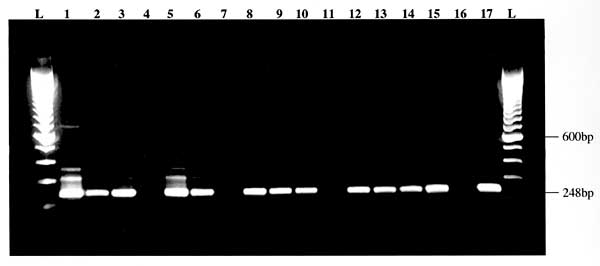Volume 7, Number 4—August 2001
THEME ISSUE
West Nile Virus
West Nile Virus
Detection of North American West Nile Virus in Animal Tissue by a Reverse Transcription-Nested Polymerase Chain Reaction Assay
Figure 1

Figure 1. . Visualization of reverse transcription-nested polymerase chain reaction product. West Nile virus-positive samples are indicated by a 248-bp band. Lane 1: positive crow brain, NY, 1999. Lane 2: positive crow kidney, NY, 1999. Lane 3: positive Sandhill Crane brain, CT, 1999. Lane 4: negative crow brain. Lane 5-6: positive crow brains, NY, 2000. Lane 7: normal control. Lane 8-10: positive horse brains, NY, 1999. Lane 11: negative horse brain. Lane 12: positive horse brain, RI, 2000. Lane 13: positive horse brain, NJ, 2000. Lane 14: positive horse brain, MA, 2000. Lane 15: positive horse brain, CT, 2000. Lane 16: normal control. Lane 17: NY99 West Nile virus control. L: 100-bp DNA ladder. Band artifacts in lanes 1, 3, 5, and 6 are due to large amount of virus present in those samples.